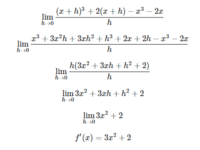onesun0000
Junior Member
- Joined
- Dec 18, 2018
- Messages
- 83
I was asked to find the derivative of the function [MATH]f(x)=x^3+2x[/MATH] using the limit definition of derivatives and find the slope at [MATH](1,3)[/MATH] and [MATH](-1,-3)[/MATH].
Here's my solution for the derivative of the function:

I have no idea how to find the slope at the points [MATH](1,3)[/MATH] and [MATH](-1,-3)[/MATH].
Here's my solution for the derivative of the function:

I have no idea how to find the slope at the points [MATH](1,3)[/MATH] and [MATH](-1,-3)[/MATH].
